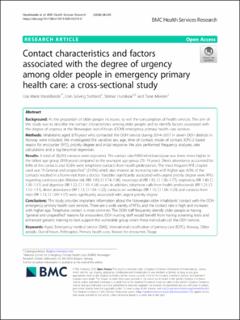| dc.contributor.author | Haraldseide, Lisa Marie | |
| dc.contributor.author | Sortland, Linn Solveig | |
| dc.contributor.author | Hunskår, Steinar | |
| dc.contributor.author | Morken, Tone | |
| dc.date.accessioned | 2021-05-31T10:40:19Z | |
| dc.date.available | 2021-05-31T10:40:19Z | |
| dc.date.created | 2020-04-23T13:27:45Z | |
| dc.date.issued | 2020 | |
| dc.Published | BMC Health Services Research. 2020, 20 (1), . | |
| dc.identifier.issn | 1472-6963 | |
| dc.identifier.uri | https://hdl.handle.net/11250/2757032 | |
| dc.description.abstract | Background
As the proportion of older people increases, so will the consumption of health services. The aim of this study was to describe the contact characteristics among older people and to identify factors associated with the degree of urgency at the Norwegian out-of-hours (OOH) emergency primary health care services.
Methods
Inhabitants aged ≥70 years who contacted the OOH service during 2014–2017 in seven OOH districts in Norway were included. We investigated the variables sex, age, time of contact, mode of contact, ICPC-2 based reason for encounter (RFE), priority degree and initial response. We also performed frequency analyses, rate calculations and a log-binomial regression.
Results
A total of 38,293 contacts were registered. The contact rate/1000 inhabitants/year was three times higher in the oldest age group (≥90 years) compared to the youngest age group (70–74 years). Direct attendance accounted for 8.4% of the contacts and 32.8% were telephone contacts from health professionals. The most frequent RFE chapter used was “A General and unspecified” (21.0%) which also showed an increasing rate with higher age. 6.0% of the contacts resulted in a home visit from a doctor. Variables significantly associated with urgent priority degree were RFEs regarding cardiovascular (Relative risk (RR) 1.85; CI 1.74–1.96), neurological (RR 1.55; CI 1.36–1.77), respiratory (RR 1.40; CI 1.30–1.51) and digestive (RR 1.22; CI 1.10–1.34) issues. In addition, telephone calls from health professionals (RR 1.21; CI 1.12–1.31), direct attendance (RR 1.13; CI 1.04–1.22), contacts on weekdays (RR 1.13; CI 1.06–1.20) and contacts from men (RR 1.13; CI 1.09–1.17) were significantly associated with urgent priority degree.
Conclusions
This study provides important information about the Norwegian older inhabitants’ contact with the OOH emergency primary health care services. There are a wide variety of RFEs, and the contact rate is high and increases with higher age. Telephone contact is most common. The OOH staff frequently identify older people as having “general and unspecified” reasons for encounters. OOH nursing staff would benefit from having screening tools and enhanced geriatric training to best support this vulnerable group when these individuals call the OOH service. | en_US |
| dc.language.iso | eng | en_US |
| dc.publisher | BMC | en_US |
| dc.rights | Navngivelse 4.0 Internasjonal | * |
| dc.rights.uri | http://creativecommons.org/licenses/by/4.0/deed.no | * |
| dc.title | Contact characteristics and factors associated with the degree of urgency among older people in emergency primary health care: a cross-sectional study | en_US |
| dc.type | Journal article | en_US |
| dc.type | Peer reviewed | en_US |
| dc.description.version | publishedVersion | en_US |
| dc.rights.holder | Copyright The Author(s). 2020 | en_US |
| cristin.ispublished | true | |
| cristin.fulltext | original | |
| cristin.qualitycode | 2 | |
| dc.identifier.doi | 10.1186/s12913-020-05219-0 | |
| dc.identifier.cristin | 1807694 | |
| dc.source.journal | BMC Health Services Research | en_US |
| dc.source.40 | 20 | |
| dc.source.14 | 1 | |
| dc.source.pagenumber | 345 | en_US |
| dc.identifier.citation | BMC Health Services Research. 2020, 20, 345. | en_US |
| dc.source.volume | 20 | en_US |

